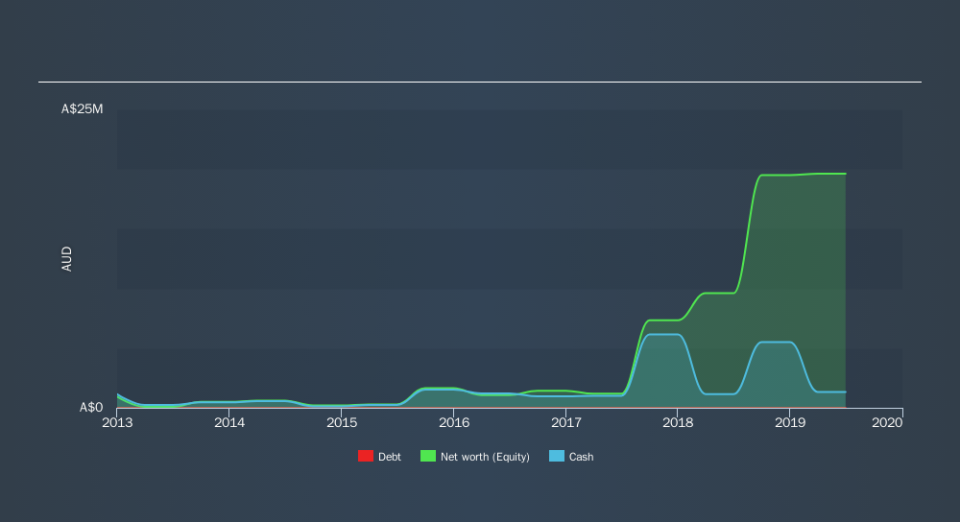Companies Like De Grey Mining (ASX:DEG) Can Be Considered Quite Risky

There's no doubt that money can be made by owning shares of unprofitable businesses. For example, although software-as-a-service business Salesforce.com lost money for years while it grew recurring revenue, if you held shares since 2005, you'd have done very well indeed. But the harsh reality is that very many loss making companies burn through all their cash and go bankrupt.
Given this risk, we thought we'd take a look at whether De Grey Mining (ASX:DEG) shareholders should be worried about its cash burn. For the purposes of this article, cash burn is the annual rate at which an unprofitable company spends cash to fund its growth; its negative free cash flow. Let's start with an examination of the business's cash, relative to its cash burn.
See our latest analysis for De Grey Mining
When Might De Grey Mining Run Out Of Money?
A cash runway is defined as the length of time it would take a company to run out of money if it kept spending at its current rate of cash burn. In June 2019, De Grey Mining had AU$1.3m in cash, and was debt-free. Importantly, its cash burn was AU$9.7m over the trailing twelve months. So it had a cash runway of approximately 2 months from June 2019. It's extremely surprising to us that the company has allowed its cash runway to get that short! The image below shows how its cash balance has been changing over the last few years.
How Is De Grey Mining's Cash Burn Changing Over Time?
Whilst it's great to see that De Grey Mining has already begun generating revenue from operations, last year it only produced AU$1.3m, so we don't think it is generating significant revenue, at this point. As a result, we think it's a bit early to focus on the revenue growth, so we'll limit ourselves to looking at how the cash burn is changing over time. Over the last year its cash burn actually increased by 26%, which suggests that management are increasing investment in future growth, but not too quickly. That's not necessarily a bad thing, but investors should be mindful of the fact that will shorten the cash runway. While the past is always worth studying, it is the future that matters most of all. For that reason, it makes a lot of sense to take a look at our analyst forecasts for the company.
How Hard Would It Be For De Grey Mining To Raise More Cash For Growth?
Since its cash burn is moving in the wrong direction, De Grey Mining shareholders may wish to think ahead to when the company may need to raise more cash. Issuing new shares, or taking on debt, are the most common ways for a listed company to raise more money for its business. Commonly, a business will sell new shares in itself to raise cash to drive growth. By comparing a company's annual cash burn to its total market capitalisation, we can estimate roughly how many shares it would have to issue in order to run the company for another year (at the same burn rate).
De Grey Mining has a market capitalisation of AU$53m and burnt through AU$9.7m last year, which is 18% of the company's market value. As a result, we'd venture that the company could raise more cash for growth without much trouble, albeit at the cost of some dilution.
How Risky Is De Grey Mining's Cash Burn Situation?
On this analysis of De Grey Mining's cash burn, we think its cash burn relative to its market cap was reassuring, while its cash runway has us a bit worried. Once we consider the metrics mentioned in this article together, we're left with very little confidence in the company's ability to manage its cash burn, and we think it will probably need more money. While it's important to consider hard data like the metrics discussed above, many investors would also be interested to note that De Grey Mining insiders have been trading shares in the company. Click here to find out if they have been buying or selling.
If you would prefer to check out another company with better fundamentals, then do not miss this free list of interesting companies, that have HIGH return on equity and low debt or this list of stocks which are all forecast to grow.
We aim to bring you long-term focused research analysis driven by fundamental data. Note that our analysis may not factor in the latest price-sensitive company announcements or qualitative material.
If you spot an error that warrants correction, please contact the editor at editorial-team@simplywallst.com. This article by Simply Wall St is general in nature. It does not constitute a recommendation to buy or sell any stock, and does not take account of your objectives, or your financial situation. Simply Wall St has no position in the stocks mentioned. Thank you for reading.


